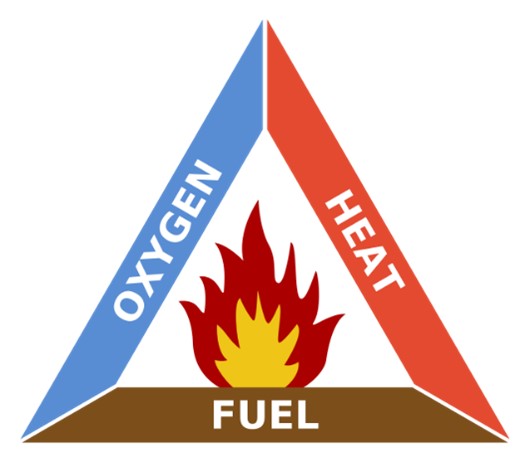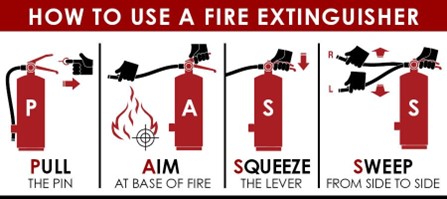Minor Fires
Minor fires are small fires that do not pose an immediate risk to the health and/or physical safety of those in the immediate area and do not involve human contamination. Minor fire can be handled by laboratory personnel if they feel comfortable doing so.
Prior to working with flammable materials, review the SDS. When working with flammable materials, remove all unnecessary equipment, oxidizers, and other chemicals that can exacerbate a fire in the event of one. If a smaller fire does become larger or out of control, please see Major Fires below for more information.
A minor fire can be handled in multiple ways if it is small enough. Utilize the fire triangle to determine the best method to put out the fire.

The fire triangle depicts the three elements a fire needs to ignite: heat, fuel, oxygen (oxidizing agent). If you are able to do so, removing one or more of the three elements will extinguisher a fire. The easiest two to remove are usually oxygen or oxidizing agent and heat.
Minor Fire Response Procedure
Consider the scenario, a 25mL beaker with 5mL of ethanol accidentally catches fire.
- Cover the beaker with a large watch glass or another larger beaker carefully. This will stifle the fire and the fire will slowly go out as the oxygen is burned off.
While attempting to cover the beaker, you have accidentally knocked the beaker over and the fire has now spread to the bench top.
- If you have sand nearby, this can be used to put out the fire. Sand works like other extinguishing materials by absorbing heat and suffocating the fire by cutting down the oxygen supply.
- If you have liquid nitrogen nearby, this can also be utilized to put out the fire. Liquid nitrogen will remove the heat from the fire and effectively put out the fire. Note that this should only be used if there is nothing else in the area, liquid nitrogen will freeze the surrounding area and can damage equipment. The initial pouring of the liquid can also knock over other items in the area.
- Use the ABC fire extinguisher near the exit.

If you do not feel 100% comfortable handling a fire, even if it is small, please see the information below for major fires on what to do and how to evacuate.
Once a fire has been put out, call RMS at 940-565-2109 to report the fire, and notify your PI or Laboratory Supervisor.
Major Fires (Emergency)
Major fires are fires that meet these criteria:
- There is a potential for explosion.
- The fire poses an immediate danger to life.
- There is a spill.
- There are injuries requiring medical attention.
- You do not know how to or feel comfortable putting out a fire.
Major Fire Response Procedure
- Stop work, (if possible) turn off any ignition sources, alert others in the immediate
area and get away and close lab doors, and evacuate building by pulling fire alarm.
- If fire is in a fume hood and able to, close fume hood sash.
- Call 911 and describe the details of the incident (chemicals involved, injuries, and any other pertinent information).
-
If an injury or personal exposure has occurred perform the above and the following as appropriate:
- Move injured persons away from danger zone if you can do so without personal risk.
- Remove any contaminated clothing and flush affected areas with copious amounts of
water from a safety shower or eye wash station for at least 15 minutes.
- If the person is on fire, have them stop, drop, and roll OR stand under the safety
shower to extinguisher the fire.
- If there is a fire blanket nearby and you are TRAINED to use a fire blanket, use one on the person. Never use a fire blanket on someone standing up as this could funnel flames towards their face and head.
- If the person is on fire, have them stop, drop, and roll OR stand under the safety
shower to extinguisher the fire.
- Administer first aid and call 911.
- Notify RMS, your PI or Laboratory Supervisor